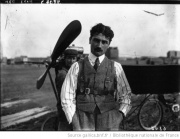Early Life and World War One↑
Roland Garros (1888-1918) was born on 6 October 1888 at Saint-Denis de la Réunion. He was a French aviation pioneer before World War I and took part in many aviation meetings and races. He became famous as the first man to cross Mediterranean Sea on 23 September 1913. Owner of several world records of altitude, he joined the MS 23 squadron when World War I began.
Later he worked with the engineer Raymond Saulnier (1881-1964) on a system of machine guns which fired through the propeller axis. The propeller was fitted with deflectors in order to deviate bullets. With his Morane Saulnier type L, Garros shot down three German planes in April 1915. Unfortunately, his plane broke down just after his third victory and he had to land in enemy territory without being able to fire.
Post-Prisoner of War Career and Death↑
Garros became a prisoner of war in Germany and tried to escape several times without success. Finally he succeeded along with another pilot Anselme Marchal (1882-1921) in February 1918. Hoping to fight again after three years in captivity, he found that technology had changed by 1918. He had to learn to pilot new aircraft like the SPAD XIII and new air combat tactics as the time of individual duels had ended long ago. He joined Squadron 26, now SPA 26, but his health became precarious and his latent myopia increasingly troublesome. However, he won a last victory before his plane exploded in midair on 5 October 1918 during a dogfight. Today, Roland Garros’ name is inseparable from the famous annual Parisian tennis tournament which was inaugurated in 1928 by Emile Lesieur (1885-1985) in memory of his friend who had been an amateur tennis player before war.
Eric Mahieu, Université Toulouse Jean Jaurès
Section Editor: Alexandre Lafon
Selected Bibliography
- Ajalbert, Jean: La passion de Roland Garros, Paris 1926: Les Éditions de France.
- Fleury, Georges: Roland Garros. Un inconnu si célèbre, Paris 2009: Bourin.
- Lefèvre-Garros, Jean-Pierre: Roland Garros. La tête dans les nuages, la vie aventureuse et passionnée d'un pionnier de l'aviation, Bruxelles 2001: Ananké/Lefrancq.
- Mortane, Jacques: Roland Garros, virtuose de l'aviation, Paris 1919: L'Edition française illustrée.
- Syndicat National des Pilotes de Ligne (SNPL) (ed.): Roland Garros, in: Icare 125/2, 1988.








